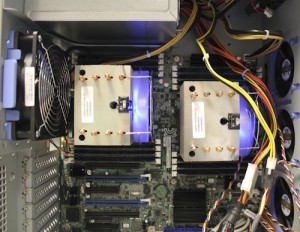TEST SETUP AND METHODOLOGY
 In testing the Samsung 845DC EVO, along with all enterprise drives, we focus on long term stability. In doing so, we stress products not only to their maximum rates, but also with workloads suited to enterprise environments.
In testing the Samsung 845DC EVO, along with all enterprise drives, we focus on long term stability. In doing so, we stress products not only to their maximum rates, but also with workloads suited to enterprise environments.
We use many off-the-shelf tests to determine performance, but we also have specialized tests to explore specific behaviors we encounter. With enterprise drives, you will see that we do not focus on many consumer level use-cases.
Our hope is that we present tangible results that provide relevant information to the buying public.
To specifically measure latency, we use a series of 512b, 4K, and 8K measurements. At each block size, latency is measured for 100% read, 65% read/35% write, and 100% write/0% read mixes.
The 845DC posted some good initial latency results. It was slightly better than the SM843 and the Intel S3500.
The 845DC scored some excellent maximum latency results. Not only were they better than the SM843, they were some of the best numbers we have ever recorded. This is definitely a good sign for the Samsung SSD.
ADVANCED WRITE TESTING
As we talked about in our Micron P400m SSD Review, SSDs have different performance states. Since the Samsung 845DC EVO is an enterprise SSD, we will focus on steady state performance. With the following tests, we stressed the drive using random 4KB write workloads across the entire span for at least 24 hours. This is more than enough to achieve steady state. The following graph is showing the latency and IOPS across an 11 hour span.
Looking at 1 minute averages, the 845DC is absolutely rock solid. Not only did we see almost no deviation, the average was close to 15K IOPS, which is higher than the 14K IOPS specification.
Now we are zooming into the last hour of our testing and looking at 1 second averages. The results here are even more impressive. As you can see, all of the data is tightly centered around 15K IOPS without any major slow-downs. The distribution is slightly better than the SM843, but the average is almost 3K IOPS better.
 The SSD Review The Worlds Dedicated SSD Education and Review Resource |
The SSD Review The Worlds Dedicated SSD Education and Review Resource | 

Do you think that they will release a 2-bit MLC version as well in the near future? it seems logical right now that Samsung will soon update its MLC 840 Pro and enterprise equal.
I dont see this but have nothing to back my view. I just think the reality of SSD lifespan coupled with low pricing trumps all.